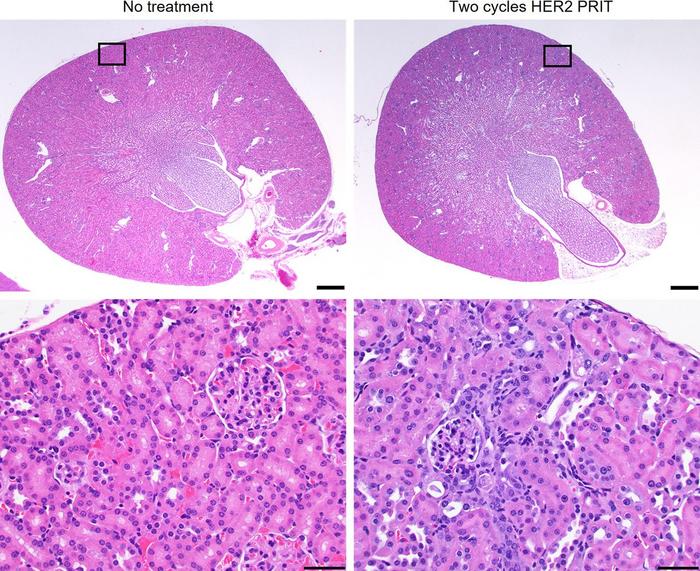Reston, VA—A new 225Ac-DOTA-based pre-targeted radioimmunotherapy (PRIT) system has been shown to cure a highly lethal form of advanced intraperitoneal ovarian cancer in a preclinical setting with minimal side effects. Targeting the HER2 protein, which is commonly expressed in ovarian cancer, the therapy (anti-HER2 225Ac-PRIT) is a potential treatment for the otherwise incurable disease. This research was published in the September issue of The Journal of Nuclear Medicine.

Credit: Images created by S. Monette, Laboratory of Comparative Pathology, Memorial Sloan Kettering Cancer Center, Weill Cornell Medicine, and Rockefeller University, New York, New York.
Reston, VA—A new 225Ac-DOTA-based pre-targeted radioimmunotherapy (PRIT) system has been shown to cure a highly lethal form of advanced intraperitoneal ovarian cancer in a preclinical setting with minimal side effects. Targeting the HER2 protein, which is commonly expressed in ovarian cancer, the therapy (anti-HER2 225Ac-PRIT) is a potential treatment for the otherwise incurable disease. This research was published in the September issue of The Journal of Nuclear Medicine.
Epithelial ovarian cancer is the most lethal ovarian cancer and frequently presents as advanced-stage disease, such as peritoneal carcinomatosis, where disease has spread throughout the peritoneal cavity. Advanced-stage disease is associated with a poor prognosis and a five-year overall survival ranging from 18 to 46 percent. Most patients die because of extensive peritoneal disease burden and malignant bowel obstruction.
“Due to the explosion of immune and targeted therapies in the past few decades—particularly those targeting HER2—there is increasing interest in the potential role of alternative, more innovative therapies to cure epithelial ovarian cancer,” said Sarah M. Cheal, PhD, of the Molecular Imaging Innovations Institute in the Department of Radiology at Weill Cornell Medical College in New York, New York. “In this study, we adapted our PRIT system to target HER2 in epithelial ovarian cancer and explored whether this could effectively treat the disease without significant toxicity.”
The preclinical study included five groups of eight to 10 nude mice, each bearing peritoneal carcinomatosis tumors. Two groups of mice were treated with either one or two cycles of anti-HER2 225Ac-PRIT; the other groups received alternative or no treatments and were used as controls. Weekly weights and tumor progression were monitored for up to 154 days.
Tumors spread rapidly in untreated mice, leading to a median survival of approximately four months. When treated with one or two cycles of anti-HER2 225Ac-PRIT, however, median survival was not reached after 154 days. At the end of the study, 75 percent of mice in the anti-HER2 225Ac-PRIT treatment groups were confirmed to be clinically cured. All treatments were well tolerated by the mice.
“In this study we achieved high potency with anti-HER2 225Ac-PRIT while maintaining an acceptable safety profile. These findings suggest that when scaled to human patients, we can achieve curative tumor radiation-absorbed doses without major normal organ toxicity” stated Steven M. Larson, MD, of the Department of Radiology at Memorial Sloan Kettering Cancer Center in New York.
“Furthermore,” stated Nai-Kong V. Cheung, MD, PhD, of the Department of Pediatrics at Memorial Sloan Kettering Cancer Center in New York, “since DOTA-based PRIT is modular it can be adapted to other cancers and next generation PRIT using SADA (Self-Assembling DisAssembling Antibody) with potential for broad applications for compartmental (e.g. peritoneal) as well as systemic theranostics in oncology.”
This study was made available online in June 2023.
The authors of “Efficacy of HER2-Targeted Intraperitoneal 225Ac α-Pretargeted Radioimmunotherapy for Small-Volume Ovarian Peritoneal Carcinomatosis” include Sebastian K. Chung, Christopher S. Chandler, Garrett M. Nash, and Andrea Cercek, Department of Surgery, Memorial Sloan Kettering Cancer Center, New York, New York; Daniela Burnes Vargas, Shin H. Seo, Blesida Punzalan and Mitesh Patel, Department of Radiology, Memorial Sloan Kettering Cancer Center, New York, New York; Sumudu Katugampola and Roger W. Howell, Division of Radiation Research, Department of Radiology and Center for Cell Signaling, New Jersey Medical School, Rutgers University, Newark, New Jersey; Darren R. Veach and Michael R. McDevitt, Department of Radiology, Memorial Sloan Kettering Cancer Center, New York, New York, and Department of Radiology, Weill Cornell Medicine, New York, New York; Brett A. Vaughn and Sarah M. Cheal, Department of Radiology, Weill Cornell Medicine, New York, New York, and Molecular Pharmacology Program, Memorial Sloan Kettering Cancer Center, New York, New York; Sara S. Rinne, Department of Radiology, Weill Cornell Medicine, New York, New York, and Department of Pediatrics, Memorial Sloan Kettering Cancer Center, New York, New York; Hong Xu, Hong-Fen Guo, and Nai-Kong V, Cheung, Department of Pediatrics, Memorial Sloan Kettering Cancer Center, New York, New York; Pat B. Zanzonico, Department of Medical Physics, Memorial Sloan Kettering Cancer Center, New York, New York; Sébastien Monette, Laboratory of Comparative Pathology, Memorial Sloan Kettering Cancer Center, Weill Cornell Medicine, and Rockefeller University, New York, New York; Guangbin Yang and Ouathek Ouerfelli, Organic Synthesis Core Facility, Memorial Sloan Kettering Cancer Center, New York, New York; Edward K. Fung, Department of Radiology, Weill Cornell Medicine, New York, New York; and Steven M. Larson, Department of Radiology, Memorial Sloan Kettering Cancer Center, New York, New York, Department of Radiology, Weill Cornell Medicine, New York, New York, and Molecular Pharmacology Program, Memorial Sloan Kettering Cancer Center, New York, New York.
Visit the JNM website for the latest research, and follow our new Twitter and Facebook pages @JournalofNucMed or follow us on LinkedIn.
###
Please visit the SNMMI Media Center for more information about molecular imaging and precision imaging. To schedule an interview with the researchers, please contact Rebecca Maxey at (703) 652-6772 or [email protected].
About JNM and the Society of Nuclear Medicine and Molecular Imaging
The Journal of Nuclear Medicine (JNM) is the world’s leading nuclear medicine, molecular imaging and theranostics journal, accessed 15 million times each year by practitioners around the globe, providing them with the information they need to advance this rapidly expanding field. Current and past issues of The Journal of Nuclear Medicine can be found online at http://jnm.snmjournals.org.
JNM is published by the Society of Nuclear Medicine and Molecular Imaging (SNMMI), an international scientific and medical organization dedicated to advancing nuclear medicine and molecular imaging—precision medicine that allows diagnosis and treatment to be tailored to individual patients in order to achieve the best possible outcomes. For more information, visit www.snmmi.org.
Journal
Journal of Nuclear Medicine
DOI
10.2967/jnumed.122.265095
Article Title
Efficacy of HER2-Targeted Intraperitoneal 225Ac a-Pretargeted Radioimmunotherapy for Small-Volume Ovarian Peritoneal Carcinomatosis
Article Publication Date
1-Sep-2023
COI Statement
This research was funded in part by the Hedvig Hricak Chair in Radiology (to Steven Larson); the Enid A. Haupt Chair (to Nai-Kong Cheung); the Center for Targeted Radioimmunotherapy and Theranostics, Ludwig Center for Cancer Immunotherapy of MSKCC (to Steven Larson); and Mr. William H. Goodwin and Mrs. Alice Goodwin and the Commonwealth Foundation for Cancer Research and the Experimental Therapeutics Center of MSKCC (to Steven Larson). Steven Larson was also supported in part by P50-CA86438. This study also received support from R01-CA233896 (to Sarah Cheal). We also acknowledge P30-CA008748 for use of the Tri-Institutional Laboratory of Comparative Pathology, MSKCC, WCM, and Rockefeller University, New York, NY; technical services provided by the MSKCC Small-Animal Imaging Core Facility and Laboratory of Comparative Pathology; as well as the Molecular Cytology Core Facility. Both MSKCC and Nai-Kong Cheung have financial interest in Y-mAbs Therapeutics, Inc., Abpro-Labs, and Lallemand-Biotec Pharmacon. Nai-Kong Cheung reports receiving commercial research grants from Y-mAbs Therapeutics, Inc., and Abpro-Labs. Nai-Kong Cheung was named as inventor on multiple patents filed by MSKCC, including those licensed to Y-mAbs Therapeutics, Inc., Lallemand-Biotec Pharmacon, and Abpro-Labs. Nai-Kong Cheung is a scientific advisory board member for Eureka Therapeutics. Nai-Kong Cheung, Steven Larson, and Sarah Cheal were named as inventors in the following patent applications relating to GPA33: SK2014-074, SK2015-091, SK2017-079, SK2018-045, SK2014-116, SK2016-052, and SK2018-068 filed by MSK. Steven Larson reports receiving commercial research grants from Genentech, Inc., WILEX AG, Telix Pharmaceuticals Limited, and Regeneron Pharmaceuticals, Inc.; holding ownership interest/equity in Elucida Oncology, Inc., and Y-mAbs Therapeutics, Inc.; and holding stock in ImaginAb, Inc. Steven Larson is the inventor and owner of issued patents both currently unlicensed and licensed by MSKCC to Samus Therapeutics, Inc., Elucida Oncology, Inc., and Y-mAbs Therapeutics, Inc. Steven Larson serves or has served as a consultant to Cynvec LLC, Eli Lilly & Co., Prescient Therapeutics Limited, Advanced Innovative Partners, LLC, Gerson Lehrman Group, Progenics Pharmaceuticals, Inc., Y-mAbs Therapeutics, Inc., and Janssen Pharmaceuticals, Inc. Guangbin Yang and Ouathek Ouerfelli are listed as inventors and receive royalties from patents that were filed by MSKCC. Ouathek Ouerfelli is an unpaid member of the scientific advisory board of Angiogenex and owns shares in Angiogenex. Andrea Cercek reports receiving research funding from GSK, Seagen, and Inspirna and is a member of the advisory board of Bayer, GSK, Merck, Janssen, G1 Therapeutics, and Seagen




